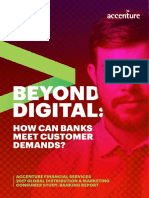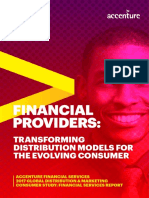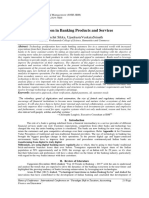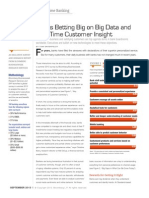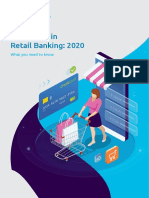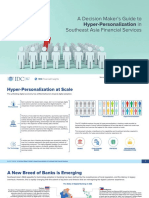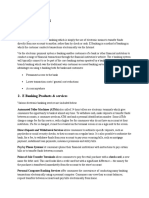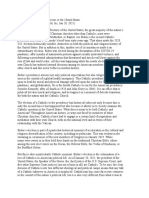Tuum - The Changing Face of Banking. February 2023.
Uploaded by
Sugestión Banca de InversiónTuum - The Changing Face of Banking. February 2023.
Uploaded by
Sugestión Banca de InversiónThe Changing
Face of Banking
How Consumer Needs Have
Evolved Since the Pandemic
and Banks’ Response to These
Table of Contents
Foreword 3
Methodology 4
Executive Summary 5
1. Saving and Money Management Services
Top the List of Consumer Demands 7
2. Access to Cryptocurrencies:
Both End Users and Banks Keen to Adopt 8
3. Loyalty Waning Particularly Among
Younger Generations 10
4. Customer Service is Still King
in Attracting New Customers 11
5. Younger Generations Driving Take-up
of Embedded Finance 13
6. Embedded Finance: Breaking Through
the Cultural and Technical Barriers 13
7. Banks are Embracing Technological
and Procedural Change 15
Learnings From the Study: Connecting With the
Evolving Needs of End Users Both Now and in the Future 17
Foreword
The last couple of years have seen the banking industry evolve at
an unprecedented rate. The pandemic and global lockdowns put
economic pressure on everyone, many people were furloughed
or lost their job and many small businesses were forced to cease
trading. In these harsh economic times, people turned to their banks
not just for support in the form of loans and overdrafts, but also to
help them better save and manage their money.
At the same time, lockdowns led to the mass closure of bank
branches. Through sheer necessity, online banking became the
norm. Demographics once adverse to the concept found themselves
logging in to online and mobile banking. People became more recep-
tive to new innovative services and increasingly intrigued by new
(regulated) start-up banks, expecting the same speed and agility
from their incumbent banks. Consumer banking requirements that
would have evolved over a decade were ushered in less than a year.
Banks and financial services providers have had to deal with struc-
tural changes to accommodate the move to online banking and at
the same time fend off increased competition from neobanks and
fintechs disrupting the market. With a greater pool to choose from
and less incentive to stay with their existing provider, consumers are
more inclined to move to the bank that offers the most convenient
services that best fit their individual needs and with the highest level
of customer service.
The aim of this study is to assess how consumer
banking needs have changed and are continuing
to change in the wake of the pandemic. We hope
to throw some useful light on evolving customer
banking needs, the steps banks are taking and
the steps they need to take to best serve
their customers in this new era of banking.
Sergei Anikin, CEO of Tuum
3 / 19
Methodology
This report was developed using statistics based on a survey
commissioned by Tuum in partnership with market research
specialists, Sapio Research. The research, which ran in
February 2022, surveyed 4,000 consumers and 313 IT decision
makers within financial institutions across the UK, Germany and
France. All organisations surveyed had 500+ employees.
The resulting data provides an overview of overall responses,
as well as responses by the demographics of age group. The age
groups discussed in this report are classified as follows:
Generation Z: 18–23-year-olds
Millennials: 24–38-year-olds
Generation X: 39–54-year-olds
Baby Boomers: 55–73-year olds
Silent generation: 74–92-year-olds
4 / 19
Executive Summary
This report looks at the demands banks and financial service
providers face from their consumers today and how they are
responding to these changing needs.
The survey was carried out on 4,000 consumers in the UK, France
and Germany and questioned them on the banking products they
currently use and the products they’d like to see introduced by their
banks. It also questioned 313 IT decision makers at financial insti
tutions on their service priorities today and their plans for the future.
Analysis of the findings reveals that end users today still seek certain
traditional banking services, but are also demanding new services
that make saving and managing their finances easier and more
convenient.
Our key findings are as follows:
• Saving and money management services top
the list of consumer demands
The current climate of financial uncertainty is driving strong
demand for ‘traditional’ banking and money saving services
across age groups. In addition, people want convenient
banking services that blend in with their everyday lives.
Banking is becoming an even more integral part of people’s
lives and products/tools that help them transfer money
among friends and family or split bills are strongly in demand,
not just by the younger tech-savvy generations but also by
older generations.
• Interest in embedded finance services is surging
Almost half of UK consumers are interested in insurance,
loans and BNPL being offered at checkout. Banks are
increasingly backing embedded finance and recognise the
commercial opportunity it represents, but obstacles in the
form of consumer reticence due to cultural and trust issues,
together with complex sign up processes, are hindering mass
market take up.
5 / 19
• Consumers want crypto-management services from banks
In line with the demand for careful money saving products
together with the broader interest in cryptocurrencies,
a significant number of consumers are expressing interest
in access to cryptocurrencies through the security of their
trusted bank; the study found that almost 1 of 5 people –
are keen to access cryptocurrencies via their bank.
• Customer loyalty continues to wane
Younger generations in particular are inclined to switch
banks to get the services they require, and if they can get
better customer service elsewhere, they will. Banks are
acutely aware of this situation and are actively seeking to
provide optimum customer service, UX, and the services
customers want.
• Banks moving to meet customer demand
The majority of banks and financial services providers are
currently transforming, or indeed, have already transformed
their tech stack in order to meet consumer demands both
now and in the future.
The chapters of this report explore these topline findings.
In analysing these results, the study draws on the extensive experi
ence of report sponsor, Tuum, a next-generation core banking
platform that is helping a wide range of banking services providers
to bring new products to market that meet with end user demand.
6 / 19
1. Saving and Money
Management Services Top
the List of Consumer Demands
Our research reveals a strong demand for traditional banking
services; savings and overdrafts were found to be the most used
banking services across age groups. Younger generations have
previously been regarded as big spenders compared to other
generations, with a more lax attitude to saving; a 2019 Morgan
Stanley report predicted the advent of an economic ‘youth boom’
as millennials entered an era of prime spending. However, our study
found the younger generations to be almost as keen to save as
their older counterparts: 57% of Gen Z and 65% of millennials have
savings accounts, compared to 64% of Gen X, 67% of baby boomers
and 74% of the silent generation. The fact that people are still keen
to keep their money in saving accounts, even with base rates at
an all-time low, would appear to symbolise the trust they have in
banks and their need to save securely.
Consumers across all age groups are keen to save
100%
74%
75% 65% 64% 67%
57%
50%
25%
0%
Gen Z Millenials Gen X Baby Silent
Boomers Generation
Banking services that allow users to split bills and send money
quickly and easily between friends are also proving to be popular
across all age groups. Interestingly, while Gen Z (34%) and millennials
(32%) are the biggest users of these sending money services, older
generations are also using them, with the baby boomer generation
not too far behind, with almost one in four using these types of
services.
7 / 19
It is clear from the study that along with ‘traditional’ banking
services (insurance, overdrafts and consumer loans), consumers
also want new banking services that help them better save and
manage their money. Such services include quick and easy money
transfer services, integrating accounts into one place, and zero
fees spending abroad.
The most popular products and services
that consumers currently use
Saving accounts 65%
Overdrafts 32%
Split bills & send money
quickly between friends 27%
Insurance 24%
Integrating accounts
18%
into one place
Mortgages 17%
Consumer loans 15%
Zero fees
13%
spending abroad
2. Access to Cryptocurrencies:
Both End Users and
Banks Keen to Adopt
In contrast to the demand for reliable and ‘traditional’ banking
services, the research highlights a growing demand from end users
for banks to offer access to cryptocurrencies; digital currencies from
peer-to-peer financial services based on public blockchain or other
decentralised ledger technologies – that are (as of now) entirely
unregulated.
8 / 19
Despite the risks involved, interest in investing in cryptocurrencies
has surged since the pandemic as a means of making money.* Our
study revealed the demand from end users specifically for banks to
get involved and open up access to cryptocurrencies. This is likely to
be a result of end users wanting to experiment with cryptocurren-
cies, but to do so via a secure and trustworthy provider to reduce
their risk.
When asked which services people would most like to see intro-
duced by banks/regulated financial institutions, access to crypto-
currency markets was the third most popular service, with 16% of
people wishing to see banks offer this. The same number of people
said that they had switched accounts or applied to open a new one
for this very reason.
Products and services consumers would
most like to see their banks introduce
20% 19%
16% 16%
15%
15%
10%
10%
5%
0%
Zero fees Spreading Access to Rounding up Multi-
spending the cost of cryptocurrency transactions currency
abroad purchase markets into a saving accounts
over time pot
While these percentages may seem low, it’s actually a strong and
significant indicator of demand that almost 1 out of 5 people would
actively like to see the introduction of banking services linked to
cryptocurrencies.
* It is worth noting that this research was carried out prior to recent global political
instabilities which have led to a negative impact on the value of many cryptocurrencies
and the crash of TerraUSD
9 / 19
Banks themselves fully acknowledge the growing need to offer
access to cryptocurrency markets. While 41% of banks said they
already offer this service, 37% said they intend to roll it out over the
coming 12 months.
3. Loyalty Waning Particularly
Among Younger Generations
People across age groups are generally open to switching to new
accounts or opening up additional ones if their current bank does
not offer the services they require. Since the pandemic, one in five
people (20%) have switched or opened additional accounts and a
further 21% have considered doing so.
Perhaps unsurprisingly, younger generations are twice as likely
to move to a new provider or to open a new account than older
generations. Around a third of Gen Z and millennials have switched
or opened up an additional account since the pandemic versus just
17% of Gen X and 9% of baby boomers. While loyalty to one bank or
brand is still prized by older generations, banks may find themselves
with a higher churn rate if they cannot satisfy the needs of younger
customers.
In terms of services attracting people to open up new accounts,
better savings rates came out top. People across age groups
flocked to new savings services which offered optimum rates and
lower charges. Just over half of 55–73-year olds and two thirds
of 74–92 year-olds who have opened an additional account have
done so to get a better savings rate. Younger generations are also
acknowledging the need to get maximum return on the money they
have in their bank accounts; 34% of Gen Z and 35% of millennials
have opened up new savings accounts since Covid hit.
The second most popular service for which people are taking out
new accounts are products which allow people to more easily send
and receive money between friends/family. This is a key driver
particularly amongst younger generations.
10 / 19
Insurance was the third most popular product for which people
have switched or opened up additional accounts, with around 17% of
people taking this out with new or current providers. In this category
there is little incongruity across groups.
Main services attracting people to open up new accounts
60%
Gen Z
40%
Millenials
Gen X
20%
Baby Boomers
Silent Generation
0%
Saving account Split bills & send money Insurance
quickly between friends
4. Customer Service is Still King
in Attracting New Customers
Customer service is still of fundamental importance to end users.
This encompasses all of a bank’s/financial services provider’s points
of interaction with customers, including in-branch, over telephone
or online/in-app help via chat. It’s not just about the availability of
help, but the speed at which issues can be resolved, rates reduced,
or accounts opened without going through lengthy and inconven-
ient verification procedures or without needing to go to a branch in
person to resolve an issue.
A bank’s customer service capabilities can be a game changer. The
survey found that better customer service (28%) coupled with ease
of use and accessibility through channels that are better suited
(21%) collectively form the key reason as to why people switched or
considered switching bank accounts.
Perception of what that customer service looks like can, however,
differ significantly between the various age groups. For older gener-
ations, this may mean having access to a local branch or being
11 / 19
put through quickly to a local call centre agent to resolve an issue.
For younger generations, this could simply mean having an intelligent
chat bot respond immediately and act on a chat request.
Of course, customer service is closely linked to customer experi-
ence, which also encroaches on the types of services available and
how well matched they are to each customer’s specific needs.’
Banks fully acknowledge that providing customers with convenient
and personalised services and rolling these out quickly is vital to
maintaining market share. When quizzed about their priorities in
developing new products, the top priorities for banks and financial
services providers lie in offering greater convenience (90% deemed
this as either very important or slightly important) and in getting a
new product out quickly. Speed is of paramount importance, with a
quarter of providers aiming to roll out services in less than 3 months
(25%) and one-third aiming to bring them to market
within 3–6 months.
The top priorities for banks and financial services
in developing new products:
• Providing greater convenience to consumers
• Getting products and services out quickly
• Consistent experience across services
• Customer data transparency
• Personalisation
12 / 19
5. Younger Generations Driving
Take-up of Embedded Finance
Overall demand for embedded services is very encouraging. The
research found that 44% of people are likely to take out insurance
at the checkout, 42% are likely to take out buy now pay later (BNPL)
and 39% are likely to take out a loan for a high value item such as a
car at the point of checkout.
Perhaps predictably, it is Gen Z and millennials that are more
receptive to new embedded finance offerings. For example, people
between the ages of 18–38 are approximately 10% more likely to take
out a BNPL product or a loan to buy a high-value item at the point of
check out than people aged 39–54 – and more than twice as likely
as people over the age of 55.
Interestingly, baby boomers (55–73 year olds) were found to be the
most likely group (56%) to take out any type of financial services
generally (e.g insurance, BNPL, payment instalments or loans)
for high-value items such as cars. This compares to 38% and 49%
of Gen Z and Millennials respectively. This highlights a huge area of
opportunity both for third party providers and banks supporting
these financial services if they could succeed in tapping further
into the baby boomer market for embedded offerings.
6. Embedded Finance:
Breaking Through the Cultural
and Technical Barriers
Our study questioned end users about how they felt about taking
out an embedded financial product from a third party (i.e. a
non-bank). Across the third parties offering embedded finance
products (including utilities, consumer technology, retailers,
13 / 19
wholesalers, leisure providers, travel providers and automotive
providers), just over half of consumers would consider them
trustworthy enough to contemplate taking out a financial service
through them.
The highest rated third parties in terms of trust are currently
retailers and utilities – 58% of consumers regard them as fully or
somewhat trustworthy. Next up are consumer tech, travel compa-
nies and automotive providers, with 55% deeming them trustworthy
followed by wholesalers and leisure providers with 52% of people
fully or somewhat trusting of them.
Therefore, aside from providing the technology to enable swift
embedded products, more work needs to be done in winning over
customer trust. Embedded finance providers such as retailers, as
well as banks enabling the concept, should seek to educate and
inform people that products taken out directly with third parties
at the point of sale still abide by the relevant regulations (e.g. the
Financial Conduct Authority (FCA) in the UK) and are underpinned
by established, licensed banks.
The survey also flagged the need for simpler and slicker processes
and technologies to avoid discouraging customers from taking
out financial services at ‘the checkout’. Across age groups, 40% of
people who had already considered using such a financial product
said they ultimately decided against it. Critically, aside from simply
forgetting or deciding their embedded product wasn’t needed,
nearly a quarter (22%) cited the reason for not continuing with their
selected embedded product at checkout as being because the
process was too complicated.
In terms of having the right banking technology, merchants and third
parties have the support of banks and financial services providers to
help them roll out embedded finance offerings. 21% of the financial
services providers surveyed said they were providing their technol-
ogies and capabilities to make BaaS or embedded finance possible,
while a huge 63% said they planned to do so in the next 12 months.
14 / 19
This is a major milestone for banks in broadening their business
focus beyond their direct end-user customers. Forward-thinking
banks are acknowledging that rather than ‘handing over’ their
customers – embedded finance simply provides them with another
‘new channel’ to get to the customer. When asked how important
(as a revenue stream) offering financial services via third parties is
to them, on a scale of 1–10, 82% of banks ranked it to be 7 or above.
7. Banks are Embracing
Technological and
Procedural Change
Although there are some discrepancies between banks and end
users in terms of how they prioritise the importance of services,
broadly banks are in tune with customer needs and aware of how
to provide an excellent customer experience.
This is exemplified by comparing responses from the two surveys
as to what banks and consumers deem to be the most important
services in an ideal world.
Banks: Consumers:
• Sending money • Zero fees spending abroad
•
between friends
Access to stocks, shares
• Access to crypto
currencies markets
•
& cryptocurrency markets
Consumer loans
• Rounding up transactions
into a savings pot
• Zero fees spending abroad • Multi-currency accounts
15 / 19
The fact that consumers consider everyday banking services such as
zero fees on spending abroad, spreading the cost of purchases over
time and rounding up transactions into a savings pot as key features
for them highlights the need for banking services to be a seamless
part of everyday life.
In line with banks’ commitment to providing the services customers
want, banks and financial services providers are introducing new
technologies and undertaking transformation programmes in order
to roll out new services more quickly.
64% 35%
Banks and financial Banks and financial services
services companies that companies that have
have already or are transformation plans in
currently transforming place, but they haven’t yet
their technology stack commenced
Rolling out new services quickly is of utmost importance to banks
in order to satisfy customers and maintain market share. When
asked how quickly banks like to roll out new services, 25% said within
3 months, 31% said between 3–6 months and 34% said between
7–12 months.
While these timelines are aspirational and indeed still somewhat
ambitious on the part of banks and financial services providers,
they highlight a willingness to move quickly to seize opportunities.
Moreover, providing banks have a flexible core banking system and
the right resources in place, rolling out services within these time-
lines would be feasible. For an industry which was once very slow
to embrace change, these findings mark the considerable progress
made by banks and financial services providers in terms of adopting
a new mindset and embracing the need to evolve quickly to meet
changing customer needs.
16 / 19
Banks are not only embracing the changes brought about by the
surge in online banking, the pandemic and new financial uncertain-
ties, but actively adapting their strategies to anticipate, and respond
to, the fast evolving needs of customers.
Learnings From the Study:
Connecting With the Evolving
Needs of End Users Both
Now and in the Future
This study shows that consumers today demand a broad range of
traditional and modern services from their bank or financial services
provider. End users are keen to adopt new banking services that
improve their quality of life, at the same time, they still demand
traditional banking services such as savings accounts. Fintechs with
a laser-focus on certain niches, such as multi-currency accounts,
have proven popular with consumers, but this research shows no
single service stands out particularly above the rest. Consumer
demand for financial services is spread across an increasingly broad
spectrum.
For banks, this presents an opportunity to greatly improve their
market standing if they can quickly roll out new, in-demand services
and still maintain a broad portfolio of traditional financial services.
The fact that a significant amount of consumers wish to see, for
example, crypto services offered by their bank, despite the avail-
ability of these services from third party providers, demonstrates
that consumers still see banks as being more stable and trusted.
Those that can diversify their portfolio to include competitively
priced traditional services as well as innovative modern offerings,
in areas such as DeFi and embedded finance, stand to gain the most
market share.
With consumers showing less allegiance to their bank and a
greater inclination to switch to new providers, now more than ever,
banks and financial service providers need to fully understand the
17 / 19
individual needs of each of their customers. They need to collate
data that gives them a complete view not only of the financial health
and status of their customers but their aspirations, goals and indi-
vidual challenges.
Having a next-generation core banking platform is fundamental in
gaining a complete view of individual customers as well as wider
trends. When coupled with a winning business strategy across the
organisation to address these needs, financial service providers can
effectively differentiate themselves from their competitors.
It is great to see digital transformation finally take hold across
the industry and to see so many players on board with updating
their technology stack. The next big task for financial services
providers is to maximise the data and insight that that technology
is now enabling them to collate, and to continue to anticipate what
customers will want next. The key to success is helping consumers
to achieve their banking, savings and investment goals.
18 / 19
tuumplatform.com
You might also like
- Digitalization Impact On Customer Experience of Banking Industry 2.No ratings yetDigitalization Impact On Customer Experience of Banking Industry 2.30 pages
- CH 03 Review and Discussion Problems Solutions57% (7)CH 03 Review and Discussion Problems Solutions23 pages
- Corporate Secretarys Certificate (BusinessPlus Account Opening) (As of February 18, 2015)No ratings yetCorporate Secretarys Certificate (BusinessPlus Account Opening) (As of February 18, 2015)4 pages
- Transforming Distribution Models For The Evolving ConsumerNo ratings yetTransforming Distribution Models For The Evolving Consumer20 pages
- Digital Banking in India A Review of Tre PDFNo ratings yetDigital Banking in India A Review of Tre PDF13 pages
- Submitted To Suhal Ahmed: Module Name: Shipping & Banking Module Code: AMM-4323No ratings yetSubmitted To Suhal Ahmed: Module Name: Shipping & Banking Module Code: AMM-43239 pages
- BAIN REPORT Evolving The Customer Experience in Banking PDFNo ratings yetBAIN REPORT Evolving The Customer Experience in Banking PDF46 pages
- Innovation in Banking Products and Services: Sanchit Sikka, UpadrastavenkatasrinathNo ratings yetInnovation in Banking Products and Services: Sanchit Sikka, Upadrastavenkatasrinath7 pages
- Customer Relationship Management in Banking Sector100% (1)Customer Relationship Management in Banking Sector4 pages
- The Digital Banking Revolution: How financial technology companies are rapidly transforming the traditional retail banking industry through disruptive innovation.From EverandThe Digital Banking Revolution: How financial technology companies are rapidly transforming the traditional retail banking industry through disruptive innovation.No ratings yet
- Yes Bank Transformation Series Caselet FinalNo ratings yetYes Bank Transformation Series Caselet Final14 pages
- accenture 2025 Accenture-Banking-Top-10-Trends-2025-Report_P48No ratings yetaccenture 2025 Accenture-Banking-Top-10-Trends-2025-Report_P4851 pages
- Banks Betting Big On Big Data and Real-Time Customer InsightNo ratings yetBanks Betting Big On Big Data and Real-Time Customer Insight5 pages
- Chapter 1 - Introduction To Digital Banking - V1.0No ratings yetChapter 1 - Introduction To Digital Banking - V1.017 pages
- Accenture Global Banking Consumer Study InfographicNo ratings yetAccenture Global Banking Consumer Study Infographic1 page
- WewegeLuigi 2017 TheFutureOfBanking TheDigitalBankingRevoNo ratings yetWewegeLuigi 2017 TheFutureOfBanking TheDigitalBankingRevo3 pages
- Digital Banking and Analytics, Enhancing Customer Experience and EfficiencyNo ratings yetDigital Banking and Analytics, Enhancing Customer Experience and Efficiency8 pages
- POV-RetailBanking - regaining customers confidenceNo ratings yetPOV-RetailBanking - regaining customers confidence25 pages
- Idc Infobrief Guide To Hyper Personalization in Sea FsiNo ratings yetIdc Infobrief Guide To Hyper Personalization in Sea Fsi18 pages
- 17-19MILLENNIALSANDMOBILE-SAVVYCONSUMERSAREDRIVINGAHUGESHIFTINTHERETAILBANKINGINDUSTRYNo ratings yet17-19MILLENNIALSANDMOBILE-SAVVYCONSUMERSAREDRIVINGAHUGESHIFTINTHERETAILBANKINGINDUSTRY4 pages
- 2025-retail-banking-trends-and-prioritiesNo ratings yet2025-retail-banking-trends-and-priorities57 pages
- DBR 272 Innovation Retail Banking REV 2020No ratings yetDBR 272 Innovation Retail Banking REV 202089 pages
- A Theoretical Model of Customer Acceptance and Use of Electronic Banking as a Distribution Channel for Banking Products and ServicesNo ratings yetA Theoretical Model of Customer Acceptance and Use of Electronic Banking as a Distribution Channel for Banking Products and Services24 pages
- Chapter: 3: E Banking 1. What Is E BankingNo ratings yetChapter: 3: E Banking 1. What Is E Banking7 pages
- The-Future-of-Digital-Banking_Whitepaper (1)No ratings yetThe-Future-of-Digital-Banking_Whitepaper (1)16 pages
- Banking in The Era of Connected Customers ROW Version - MoEngage100% (1)Banking in The Era of Connected Customers ROW Version - MoEngage53 pages
- Fsi Anticipating Bank Customer Needs PWCNo ratings yetFsi Anticipating Bank Customer Needs PWC12 pages
- Jaiib Rbwl PDF 1 Special Notes on All Mudules Papar 4 (1)No ratings yetJaiib Rbwl PDF 1 Special Notes on All Mudules Papar 4 (1)204 pages
- future-of-digital-banking-in-2030-cba.pd (3).pdf_20241217_002817_0000No ratings yetfuture-of-digital-banking-in-2030-cba.pd (3).pdf_20241217_002817_000016 pages
- Digital Transformation and Customers Services The Banking RevolutionNo ratings yetDigital Transformation and Customers Services The Banking Revolution5 pages
- Digital Core.: A Guide On True Digital TransformationNo ratings yetDigital Core.: A Guide On True Digital Transformation11 pages
- DBR 260 2019 Retail Banking Trends and PredictionsNo ratings yetDBR 260 2019 Retail Banking Trends and Predictions118 pages
- 0847 Cgi Gtnews - Transaction Banking Services Survey Report 2017 FinalNo ratings yet0847 Cgi Gtnews - Transaction Banking Services Survey Report 2017 Final63 pages
- EIB Working Papers 2019/01 - Blockchain, FinTechs: and their relevance for international financial institutionsFrom EverandEIB Working Papers 2019/01 - Blockchain, FinTechs: and their relevance for international financial institutionsNo ratings yet
- The South Indian Bank LTD., Regd. Office: Thrissur, KeralaNo ratings yetThe South Indian Bank LTD., Regd. Office: Thrissur, Kerala3 pages
- The Metro Railways (Construction of Works) Act, 1978-2021No ratings yetThe Metro Railways (Construction of Works) Act, 1978-202126 pages
- Statement of Account: Date Narration Chq./Ref - No. Value DT Withdrawal Amt. Deposit Amt. Closing BalanceNo ratings yetStatement of Account: Date Narration Chq./Ref - No. Value DT Withdrawal Amt. Deposit Amt. Closing Balance7 pages
- Date: 26/11/2018 FILE No.: 875146: Instrument Type Instrument No. Instrument Date Amount (INR) Infavour ofNo ratings yetDate: 26/11/2018 FILE No.: 875146: Instrument Type Instrument No. Instrument Date Amount (INR) Infavour of21 pages
- Free Access to Physical Chemistry Thermodynamics Statistical Mechanics and Kinetics Cooksy Solution Manual Chapter Answers100% (23)Free Access to Physical Chemistry Thermodynamics Statistical Mechanics and Kinetics Cooksy Solution Manual Chapter Answers26 pages
- Dnvgl-Ru-Ships (2015) Part 3 Ch-10 TrolleyNo ratings yetDnvgl-Ru-Ships (2015) Part 3 Ch-10 Trolley7 pages
- Laporan Tahunan: PT Bumi Teknokultura Unggul TBKNo ratings yetLaporan Tahunan: PT Bumi Teknokultura Unggul TBK194 pages
- Adam Bensman The Copywriters 6-Figure Income SprintNo ratings yetAdam Bensman The Copywriters 6-Figure Income Sprint5 pages
- Business Valuation M&a and Post Merger IntegrationNo ratings yetBusiness Valuation M&a and Post Merger Integration63 pages
- The Court Shall Impose The Appropriate Disposition Measures in Consideration of The Various Circumstances of The CICLNo ratings yetThe Court Shall Impose The Appropriate Disposition Measures in Consideration of The Various Circumstances of The CICL2 pages
- Chapter – 2 SOCIALISM IN EUROPE AND THENo ratings yetChapter – 2 SOCIALISM IN EUROPE AND THE28 pages
- NEET-UG-2019: Admission Process For Health Science CoursesNo ratings yetNEET-UG-2019: Admission Process For Health Science Courses2 pages






